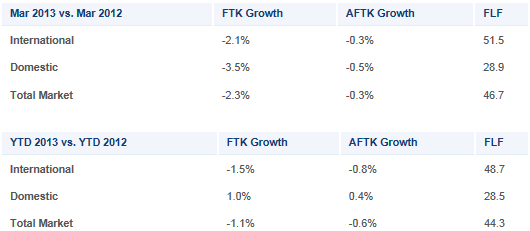Freight markets weaken in March
- Like
- Digg
- Del
- Tumblr
- VKontakte
- Buffer
- Love This
- Odnoklassniki
- Meneame
- Blogger
- Amazon
- Yahoo Mail
- Gmail
- AOL
- Newsvine
- HackerNews
- Evernote
- MySpace
- Mail.ru
- Viadeo
- Line
- Comments
- Yummly
- SMS
- Viber
- Telegram
- Subscribe
- Skype
- Facebook Messenger
- Kakao
- LiveJournal
- Yammer
- Edgar
- Fintel
- Mix
- Instapaper
- Copy Link
Posted: 30 April 2013 | IATA | No comments yet
IATA released figures showing that air freight markets weakened in March, and that the improvement in air cargo growth rates that began towards the end of 2012 has stalled…


The International Air Transport Association (IATA) released figures showing that air freight markets weakened in March, and that the improvement in air cargo growth rates that began towards the end of 2012 has stalled.
Global Freight Tonne Kilometers (FTKs) were down 2.3% in March compared to March 2012, with only the Middle East and Africa showing an expansion. Asia-Pacific carriers are the largest players in air freight (together they comprise 38.5% of the market). With a 3.3% fall compared to the previous year, this region showed the greatest weakness in terms of actual freight volumes. The US and Europe, however had larger percentage falls (5.2% and 4.0% respectively), but on a smaller market share. Global air freight volumes are now only 1.5% above the October 2012 low point, down from the 3.5% rise that had been reached in January.
“The March decline in air cargo is most likely a temporary stall. The fundamentals for a sustained improvement in air cargo volumes are in place. Business confidence continues to signal forthcoming expansion, and the solid increase in new export orders seen in 2013 should boost air freight in the coming months. Much of the current weakness is coming from Asia-Pacific airlines. While the region is economically strong, the economies of its trading partners are not. The Eurozone is showing renewed weakness and the negative impact of US budget cuts is yet to be fully measured,” said Tony Tyler, IATA’s Director General and CEO.


Regional highlights
After adjusting for seasonal factors, it is clear that the improving trend witnessed in the fourth quarter of 2012 has been reversed. The global load factor slipped marginally to 46.7%, and capacity fell by 0.3%.
Asia-Pacific carriers saw cargo traffic fall 3.3% compared to March 2012. Airlines in the region have experienced most of the weakness in the global trend, with a 3% drop in volumes in March compared to January this year. Although regional indicators are still solid, major trade partners in Europe continue to be hampered by economic weakness and sovereign debt problems. Capacity also fell, down 2.8%, compared to a year ago.
North American airlines experienced a 5.2% decline in demand, the steepest fall of any region. Capacity was reduced by 2.7%. While domestic demand has supported regional cargo carriers, routes to Europe have been hit by declines in export markets.
European cargo markets fell 4.0% and capacity grew 0.4%. Several European confidence indicators declined in March and much of Western Europe remains in or close to recession.
Middle East airlines’ cargo traffic grew 10.5%, continuing their remarkable start to 2013. The region has grown 12.4% faster for the year to date compared with the same period last year. In March, capacity was up 9.1%.
Latin American carriers saw demand fall 0.8% while capacity grew 2.6%. The underlying economic growth trend in the region is still solid and airlines are maintaining the improvement in demand since late 2012. Export growth to North America and China is supporting international freight routes.
African cargo markets grew 3.2%, benefitting from strong growth in regional developing economies. Capacity, however, grew by 10.0% which led to the load factor declining to 25.0%, the lowest of all regions.
View full March air freight results (pdf)













